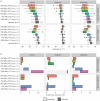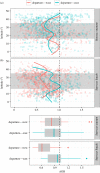Negotiating an ecological barrier: crossing the Sahara in relation to winds by common swifts
- PMID: 27528783
- PMCID: PMC4992717
- DOI: 10.1098/rstb.2015.0393
Negotiating an ecological barrier: crossing the Sahara in relation to winds by common swifts
Abstract
The Sahara Desert is one of the largest land-based barriers on the Earth, crossed twice each year by billions of birds on migration. Here we investigate how common swifts migrating between breeding sites in Sweden and wintering areas in sub-Saharan Africa perform the desert crossing with respect to route choice, winds, timing and speed of migration by analysing 72 geolocator tracks recording migration. The swifts cross western Sahara on a broad front in autumn, while in spring they seem to use three alternative routes across the Sahara, a western, a central and an eastern route across the Arabian Peninsula, with most birds using the western route. The swifts show slower migration and travel speeds, and make longer detours with more stops in autumn compared with spring. In spring, the stopover period in West Africa coincided with mostly favourable winds, but birds remained in the area, suggesting fuelling. The western route provided more tailwind assistance compared with the central route for our tracked swifts in spring, but not in autumn. The ultimate explanation for the evolution of a preferred western route is presumably a combination of matching rich foraging conditions (swarming insects) and favourable winds enabling fast spring migration.This article is part of the themed issue 'Moving in a moving medium: new perspectives on flight'.
Keywords: barrier crossing; common swift; migration; migration routes; the Sahara; wind assistance.
© 2016 The Author(s).
Figures



References
-
- Moreau RE. 1961. Problems of Mediterranean–Saharan migration. Ibis 103, 373–427.
-
- Moreau RE. 1972. Palaearctic–African bird migration systems. London, NY: Academic Press.
-
- Hahn S, Bauer S, Liechti F. 2009. The natural link between Europe and Africa—2.1 billion birds on migration. Oikos 118, 624–626. (10.1111/j.1600-0706.2008.17309.x) - DOI
-
- Alerstam T, Hedenström A, Åkesson S. 2003. Long-distance migration: evolution and determinants. Oikos 103, 247–260. (10.1034/j.1600-0706.2003.12559.x) - DOI
Publication types
MeSH terms
LinkOut - more resources
Full Text Sources
Other Literature Sources

